|
What is
Kenzan Pottery?
BOOKS BY
RICHARD WILSON
click to buy
at Amazon




Yellin's gallery
sells pieces from
the kilns of Japan's
finest potters
|
|
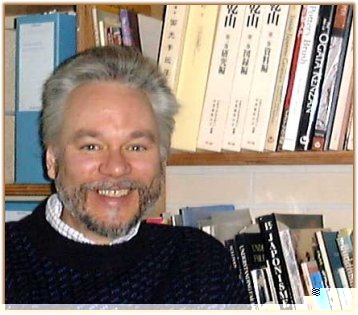
Richard L. Wilson
"Sensational art finds are both desired and feared,
desired because they become a form of pleasure and capital,
feared because they displace something or somebody.
Japan has had its share of such moments."
So writes Professor Richard L. Wilson in his new book "The Potter's Brush," which catalogues the extensive collection of the Edo-period ceramic artist Ogata Kenzan (1663-1743) at the Freer Gallery of Art and Arthur M. Sackler Gallery, Smithsonian Institution. Actually Prof. Wilson is the world's leading authority on this important figure in Japanese art and has published a three-volume set on the original Kenzan and all the fakes and imitations that abound, thus the concern in his opening lines from the new book.
Prof. Wilson is also the author of "Inside Japanese Ceramics," another fine book that takes up more of the practical side of ceramic making, Wilson having been a working potter in the past. I was fortunate enough to catch up with him between his busy teaching schedule at International Christian University. We began the talk in his office with our first encounters with Japanese pottery.

INTERVIEW WITH RICHARD WILSON
Story excerpts appeared in Dec. 11, 2002, edition of the Japan Times
Yellin: Well, for me it was going to a ryokan and seeing thirty small dishes of varying sizes and shapes. And then someone gave me a Bizen yunomi and I wondered what kind of aesthetic was going on here. What was it for you?
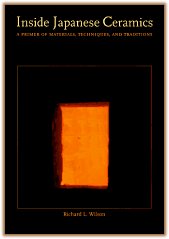 Wilson: I can remember two episodes. One is early and indirect and the other is very directly related to my research today. My father was importing Dutch tulip bulbs from the Netherlands and they used to send gifts of Delftware along with the tulips. And so even as a child I was fascinated with blue-and-white. That was my earliest association with ceramics. Then when I was at the University of Hawaii I was studying Chinese and Japanese, and when I got tired of memorizing kanji I used to go to the art section of the library. I found a book by Herbert Sanders, "The World of Japanese Ceramics," and I opened it to a page that had an illustration of a teabowl by Ogata Kenzan decorated with plum blossoms -- it's now in the Miho Museum by the way -- and I thought it was incredible. I wound up being a good correspondent of Sanders and he encouraged me so much to actually do this book. (Wilson holds up his "Inside Japanese Ceramics"' book). Wilson: I can remember two episodes. One is early and indirect and the other is very directly related to my research today. My father was importing Dutch tulip bulbs from the Netherlands and they used to send gifts of Delftware along with the tulips. And so even as a child I was fascinated with blue-and-white. That was my earliest association with ceramics. Then when I was at the University of Hawaii I was studying Chinese and Japanese, and when I got tired of memorizing kanji I used to go to the art section of the library. I found a book by Herbert Sanders, "The World of Japanese Ceramics," and I opened it to a page that had an illustration of a teabowl by Ogata Kenzan decorated with plum blossoms -- it's now in the Miho Museum by the way -- and I thought it was incredible. I wound up being a good correspondent of Sanders and he encouraged me so much to actually do this book. (Wilson holds up his "Inside Japanese Ceramics"' book).
Yellin: Seeing works in books can leave a deep impression in one's mind. I vividly recall seeing works by the late Bizen potter Fujiwara Ken and also by the late Mino potter Okuiso Eiroku and the images struck me in the solar plexus. I had no idea who they were then.
Wilson: Intuitive. The other thing that surprised me was the quality of his decoration; to me it seemed like French impressionist painting-impromptu, no outlines, fresh color. Here this potter was in 18th century Japan -- it was a total disconnect until I realized that Kenzan was picked up by French artists and he was part of the "Japonisme"movement that was appropriated by the Rimpa School (Korin, Koetsu, Sotatsu) and other artists into European taste.
Yellin: Mostly glass artists?
Wilson: Glass artists, ceramic artists, and painters were all part of Japonisme. So, there's a connection there with Kenzan, which of course took me years to realize. At that time I was in kind of a cultural vertigo. I was "reading" this as European but it's actually quite Japanese.
Yellin: You wrote the definitive book, actually a three-volume set, on Kenzan in Japanese -- what led you into writing that?
Wilson: This is a long story but it began with another serendipity-like encounter. I went to Japan after graduation; one of my goals was to study pottery and eventually I found a really good teacher, a master of Takatori ware. He told me I should learn more about Japanese culture before I do pottery. And so I went up to Kyoto and spent a year there doing tea ceremony and studying Zen and other things related to ceramics culture. While I was there, hiking in a forest with a friend of mine who was the son of a Zen priest, we came upon a temple in the mountains. I said to him, "What's this place?" and he said, "It's a Zen temple, let's go in." I was afraid to go into a Zen temple thinking I'd get beat-up or turned into a really straight Zen Buddhist. But he said, "no let's go in" and since he was the son of a priest he had no qualms about it at all. So we went in there and the abbot was a really warm, wonderful person and he said, "I've got something to show you," and he pulled out boxes and boxes of Kenzan's pot shards. It was Kenzan's kiln!
Yellin: What temple was that?
Wilson: Hozoji in the northwest hills of Kyoto, and, as it turns out, I'm presently part of the group that is excavating it. But that first look was breathtaking. It was like looking at a modern potter's shard pile because it was so fresh, so diverse and so personalized. And I thought here is another disconnect. I was looking at this from a 20th century mentality and it looks 20th century but I know it's 18th century. At that time I was debating whether to continue in pottery or to study more about history -- Kyoto, where I had been living, was so steeped in tradition. So I made a choice, and returned to the US for graduate school, and I decided to make Kenzan my topic. I came back to Japan in the early 1980s, first as a Fulbright Fellow and then under the Japan Foundation. I went to Kyoto Geidai. My advisor, Sato Masahiko, had done some work on Kenzan, and since he was also the university president, he could open many doors. I really wanted to also continue studio pottery if possible, and I had never worked full-time in a studio in Japan but I had to write this dissertation. So, I asked my advisor, "Can I have a studio at Geidai?" -- it's an art school, but they also had an art history department. And he said yes, I can do it for you. And so I worked at Geidai for three years in a pottery studio and doing art history together. My pottery teacher was the student of Tomimoto Kenkichi who had some claim to the Kenzan line himself. Other important potters like Suzuki Osamu and Fujihira Shin were in the facility -- it was a good time to be there.
Yellin: I just love Fujihira Shin's work---so playful and the glazes.
Wilson: He doesn't fit in to any established school, does he?
Yellin: No, not at all.
Wilson: He's out of the mold, isn't he? At Geidai I tried to put the practical and historical aspect together. I translated Kenzan's pottery manuals and I just went everywhere that Kenzan said one should go to get glaze materials, clay materials. I went to construction sites and got to know the hardhats and they'd yell, "Hey Wilson-san, we got some interesting clay here! We'll give it to you." That was a really happy three years. I had lots of great adventures both in making pottery, reconstructing Kenzan's techniques, and finally writing a Ph.D about Kenzan's life and work. Even though Kenzan is a very controversial topic, I met dozens of people who helped me in countless ways. I received my final degree in 1985 and then I got a call from the Smithsonian saying they have this big collection of Kenzan pottery and no one has studied it before. They said it arrived at their door in the late 1890s, brought by the Detroit industrialist Charles Freer, and they asked me if I wanted to work on it. So, I went there and worked on this Freer collection, which eventually resulted in "The Potter's Brush," which just came out last year.
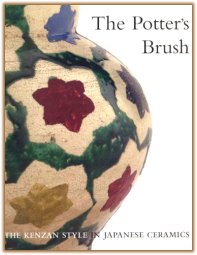 Yellin: When did you start on that one? Yellin: When did you start on that one?
Wilson: Way back in 1985! It took me more than ten years! I did get a lot of other things done in between though. So, as I was doing that, I realized a ton of Japanese ceramics had been imported into America and Europe in the Meiji period. Most of them are export quality work, but there were other things too and they've been totally neglected except for a few choice places. And so I said, gee, I'd better go to all these places. So together with Ogasawara Saeko, my research partner, we traveled all over -- to Canada and Europe, to all the old museums, and we surveyed all the old ceramics.
Yellin: How long were you on that journey?
Wilson: It took a lot of time. We were actually asked at some places to wash off pottery ourselves in some very famous museums -- the pieces were totally gray! You couldn't tell what was underneath the dust. It was quite extraordinary actually. All of these surveys, plus a good amount of thinking and editing, resulted in that three-volume set, and, as I just mentioned, "The Potter's Brush."
Yellin: Did you find any treasures?
Wilson: We found some good Edo-period stuff, but Momoyama treasures were not part of the Meiji mentality. But mid-Edo period -- nice porcelains, stonewares -- definitely.

Fake or Real Kenzan?
Yellin: Back to Kenzan, I've heard that only a handful of what we see was actually made by the man himself.
Wilson: Of what is out there, one percent probably.
Yellin: And the rest are from apprentices down the line.
Wilson: Everything, from authorized successors, unauthorized successors, hobbyists who appropriated his name, downright forgers and fakers, and its still going on.
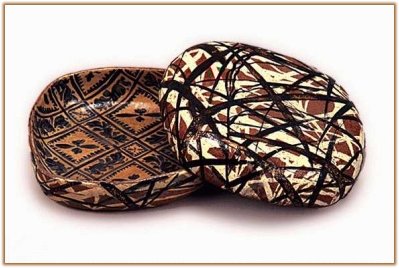
Covered dish by Kenzan Ogata at the Suntory Museum of Art
Yellin: What do you think is the appeal that would make one want to create Kenzan-style works?
Wilson: His name became famous, a brand name even in his own age. He was listed as a souvenir in 1715. But the Kenzan line actually died out after the first or second Kenzan and the rest are largely confected. Kenzan's skills were not something that could be packaged and transmitted from one generation to the next.
Yellin: Where do you place Kenzan in terms of importance in Japan's ceramic history?
Wilson: He was a groundbreaker. Nowadays we take the idea of artist-potter as common sense, right. Then when we think about where it all began, it had to begin in a period where's there's increased leisure, literacy, information and a growing recognition of personal rather than simply manual talents -- that environment takes place in the 17th and 18th centuries. And in particular it takes us to Kyoto where you had a high level of patronage, a high level of information, a high level of social mobility, and that makes many things possible. And prior to that time making ceramics was an industrial occupation and regardless of their formal social rank, clay workers were pretty low on the social scale. But Kenzan changed much of that. He himself was from a line of cultivated merchants, so he took a high-culture knowledge base and infused it into ceramics and figured out how to bring the technical and informational parts together. He was the first to do it to be sure.
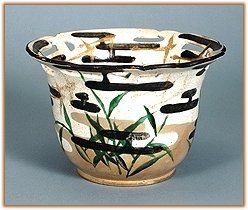
Piece by Kenzan Ogata
Photo courtesy Asia Society
Yellin: I see you have in Japanese a "Kenzan-yaki nyumon (A Beginner's Guide to Kenzan)" -- what's that book all about?
Wilson: After the large three-volume set came out, the editor asked us to put out an affordable book and one with a very high graphic content. This allows readers to follow step by step to see where Kenzan's background was, what the material environment was, what Kyoto was like, what Kenzan's sources of inspiration were, the methods of manufacture-research and studio experiment that went into the design.
Yellin: Based on your own studio experiments?
Wilson: Um-hum.
Yellin: When you were at Kyoto Geidai and trying to make exactly what he was making?
Wilson: As closely as possible.
Yellin: How'd you do?
Wilson: Well, it was very difficult! Some of Kenzan's shapes are so foreign to clay, especially these square dishes (kakuzara). They're like wood-framed vessels. They're only 3-4 millimeters thick, that's really difficult. They warp. Yet look at the originals and they're perfectly straight.
Yellin: So, what was the secret?
Wilson: Slow drying. It took me a long time to figure that out. Actually Tomimoto's student told me that's how Tomimoto did his. And so we did this frame by frame, reconstructing Kenzan's own work, the second generation's work -- we delineated Kenzan's career and then very clearly delineated the imitations and fakes which had never been done before by anybody.

Page from "Kenzan-Yaki Nyumon - A Beginner's Guide to Kenzan"
Above Kanji reads "KENZAN" - Various signatures on Kenzan pieces
Yellin: How did the Japanese ceramic world, and in particular scholars, react to your books?
Wilson: I was really very apprehensive about it at first since we divided the works clearly into first generation Kenzan, second generation Kenzan, all the way down to 20th century forgeries. This had never been done before. But as it turned out, in addition to the scholarly community, the warmest supporters of the book were the top art dealers in Japan, actually the very best of them. We had an inaugural lecture to celebrate the big book and one of the best dealers, who had a lot invested in Kenzan, came up to me and said, "Finally, Kenzan is solved. We've been waiting a long time for a book like that." I was astonished.
Yellin: Now that you've done Kenzan like no other -- you've written the definitive book -- of course Kenzan will always be with you. What are you focusing on now?
Wilson: I'm going to write a history of Japanese ceramics. All the current ones are out of date and none of them have the methodological breadth that's required. We have to include ethnological, archaeological and technical approaches as well as traditional art history. All of the earlier books were written before the explosion of historical archaeology in Japan. Our understanding of Japanese ceramics has changed profoundly since 1980. When you do archaeology you're always hesitant to commit to paper because the next week there may be a discovery that overturns all of your research, but now, with fewer new excavation projects being undertaken, we have time to take stock of the field.
Yellin: How did you get involved with archaeology. Was it down in Kyoto?
Wilson: About a decade ago, I heard that a lot of Momoyama-period ceramics had been excavated from a subway construction site. So, I went to see them with a professor from Doshisha University named Suzuki Shigeharu who was also interested in that subject. He took me around and I got to see all kinds of interesting things. I was astonished. I realized at that time, that to understand Japanese ceramics, anyone with the slightest claim to authority would need to be interested in archaeology. At that time the I.C.U. position came up and as it turned out, Professor Kidder who had been here before I was, a great Jomon specialist, was also the director of a team that had originally worked on Jomon and Paleolithic sites, but also during the "bubble-economy" period had supervised the excavation of samurai-class residence sites from Edo. When I arrived, the Tokyo Metropolitan Government asked me if I would take it over. The first site I worked on was Shiodome, which was the huge Date family residence and now the site of the Yurikamome station. That was a great experience!
Yellin: What came out of there?
Wilson: Everything.
Yellin: For example?
Wilson: Well, Kenzan came out, the best Kenzans from Edo, Kutani, Arita ware, and a lot of Chinese ceramics. I was not on the digging team for that project, but wrote for the site report -- three volumes over a thousand pages. The projects that I personally supervised were in Bunkyo-ku.
Yellin: Were these samurai residences?
Wilson: These were hakomoto sites, that is, the homes of military men, but men who were direct retainers to the shogun rather than regional daimyo. This site for example in Bunkyo-ku, the site of the present Mukogaoka High School, yielded a storeroom that was filled with 17th century Chinese porcelain. Nothing like this had been discovered before in such numbers.
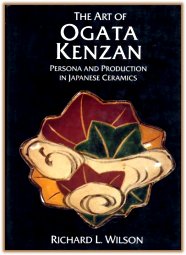 Yellin: In this book, I'm also seeing some ceramics from the late Edo-Meiji period as well. Were these all from the same site? Yellin: In this book, I'm also seeing some ceramics from the late Edo-Meiji period as well. Were these all from the same site?
Wilson: Well, within a site there's a lot of different formations. We call them features. There are wells, there are ditches, and there are storerooms. A lot of underground storerooms in Edo because people didn't have any place to leave anything, for the city was already too congested. These are like time capsules, for people discarded things at different times from the 17th through the 19th century. When processing these artifacts, one can actually see and handle large numbers of things and understand the context for literally thousands and thousands of wares. That's the way ceramics should be looked at. It's not art appreciation per se, but it certainly enhances it.
Yellin: We approach the subject from very different angles. I am fascinated with what you're doing and I know to understand Japanese ceramics one has to look at all of its history. But I'd rather look at what's going on now in the ceramics world.
Wilson: There's a lot to be said for that.
Yellin: There is indeed and it's very complimentary in a way. Yet, for example, looking at Koyama Fujio's books, there's nothing like what you're doing. He did go to China and other places, though.
Wilson: For his time, Koyama was at the cutting edge; he was really an astute observer. There was nobody like him. He still reads fresh even today but in those days, for example, the Edo period, which I work on, was not regarded as valuable archaeologically -- it was thrown away. But archaeology is important for any period. The mechanism of saving certain types, the mechanism of elevating certain genres into art, of course the dynamics of use, the dynamics of recycling and discarding -- all of those things are really taught to us by archaeology. I can't imagine studying the field without that now. People interested in beautiful ceramics have so much to look at in museums and galleries. It may not be a handicap to them but if you really want to capture the whole phenomenon then archaeology is worthwhile. After long study, I think that the emerging discipline of "material culture," which combines anthropology, art history, archaeology and cultural studies, is the best way to proceed.

And on that note we ended our talk for I had to catch a shinkansen back to Mishima! Prof Wilson is a great asset to the Japanese art world and I for one deeply thank him for all his writings and friendship---all his books are highly recommended.
|